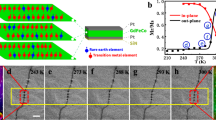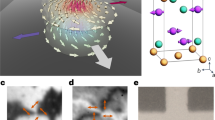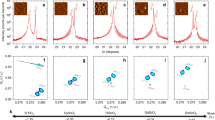Abstract
Topologically protected spin whirls in ferromagnets are foreseen as the cart-horse of solitonic information technologies. Nevertheless, the future of skyrmionics may rely on antiferromagnets due to their immunity to dipolar fields, straight motion along the driving force and ultrafast dynamics. While complex topological objects were recently discovered in intrinsic antiferromagnets, mastering their nucleation, stabilization and manipulation with energy-efficient means remains an outstanding challenge. Designing topological polar states in magnetoelectric antiferromagnetic multiferroics would allow one to electrically write, detect and erase topological antiferromagnetic entities. Here we stabilize ferroelectric centre states using a radial electric field in multiferroic BiFeO3 thin films. We show that such polar textures contain flux closures of antiferromagnetic spin cycloids, with distinct antiferromagnetic entities at their cores depending on the electric field polarity. By tuning the epitaxial strain, quadrants of canted antiferromagnetic domains can also be electrically designed. These results open the path to reconfigurable topological states in multiferroic antiferromagnets.
This is a preview of subscription content, access via your institution
Access options
Access Nature and 54 other Nature Portfolio journals
Get Nature+, our best-value online-access subscription
$29.99 / 30 days
cancel any time
Subscribe to this journal
Receive 12 print issues and online access
$259.00 per year
only $21.58 per issue
Buy this article
- Purchase on Springer Link
- Instant access to full article PDF
Prices may be subject to local taxes which are calculated during checkout




Similar content being viewed by others
Data availability
The data that support this work are available via Zenodo at https://doi.org/10.5281/zenodo.10875991 (ref. 36).
References
Junquera, J. et al. Topological phases in polar oxide nanostructures. Rev. Mod. Phys. 95, 025001 (2023).
Yadav, A. K. et al. Observation of polar vortices in oxide superlattices. Nature 530, 198–201 (2016).
Das, S. et al. Observation of room-temperature polar skyrmions. Nature 568, 368–372 (2019).
Zhang, Q. et al. Nanoscale bubble domains and topological transitions in ultrathin ferroelectric films. Adv. Mater. 29, 1702375 (2017).
Han, L. High-density switchable skyrmion-like polar nanodomains integrated on silicon. Nature 603, 63–67 (2022).
Kim, K.-E. et al. Configurable topological textures in strain graded ferroelectric nanoplates. Nat. Commun. 9, 403 (2018).
Ma, J. et al. Controllable conductive readout in self-assembled, topologically confined ferroelectric domain walls. Nat. Nanotechnol. 13, 947–952 (2018).
Yang, W. et al. Quasi-one-dimensional metallic conduction channels in exotic ferroelectric topological defects. Nat. Commun. 12, 1306 (2021).
Li, Z. et al. High-density array of ferroelectric nanodots with robust and reversibly switchable topological domain states. Sci. Adv. 3, e1700919 (2017).
Han, M.-J. et al. Shape and surface charge modulation of topological domains in oxide multiferroics. J. Phys. Chem. C 123, 2557–2564 (2019).
Yang, W. et al. Nonvolatile ferroelectric‐domain‐wall memory embedded in a complex topological domain structure. Adv. Mater. 34, 2107711 (2022).
Mermin, N. D. The topological theory of defects in ordered media. Rev. Mod. Phys. 51, 591–648 (1979).
Gross, I. et al. Real-space imaging of non-collinear antiferromagnetic order with a single-spin magnetometer. Nature 549, 252–256 (2017).
Sosnowska, I., Neumaier, T. P. & Steichele, E. Spiral magnetic ordering in bismuth ferrite. J. Phys. C Solid State Phys. 15, 4835–4846 (1982).
Lebeugle, D. et al. Electric-field-induced spin flop in BiFeO3 single crystals at room temperature. Phys. Rev. Lett. 100, 227602 (2008).
Burns, S. R., Paull, O., Juraszek, J., Nagarajan, V. & Sando, D. The experimentalist’s guide to the cycloid, or noncollinear antiferromagnetism in epitaxial BiFeO3. Adv. Mater. 32, 2003711 (2020).
Haykal, A. et al. Antiferromagnetic textures in BiFeO3 controlled by strain and electric field. Nat. Commun. 11, 1704 (2020).
Zhong, H. et al. Quantitative imaging of exotic antiferromagnetic spin cycloids in BiFeO3 thin films. Phys. Rev. Appl. 17, 044051 (2022).
Finco, A. et al. Imaging topological defects in a noncollinear antiferromagnet. Phys. Rev. Lett. 128, 187201 (2022).
Waterfield Price, N. et al. Electrical switching of magnetic polarity in a multiferroic BiFeO3 device at room temperature. Phys. Rev. Appl. 8, 014033 (2017).
Johnson, R. D. et al. X-Ray imaging and multiferroic coupling of cycloidal magnetic domains in ferroelectric monodomain BiFeO3. Phys. Rev. Lett. 110, 217206 (2013).
Waterfield Price, N. et al. Strain engineering a multiferroic monodomain in thin-film BiFeO3. Phys. Rev. Appl. 11, 024035 (2019).
Thiaville, A., Miltat, J. & Rohart, S. in Magnetic Skyrmions and Their Applications (eds Finocchio, G. & Panagopoulos, C.) 1–30 (Woodhead Publishing, 2021).
Park, M. et al. Three-dimensional ferroelectric domain imaging of epitaxial BiFeO3 thin films using angle-resolved piezoresponse force microscopy. Appl. Phys. Lett. 97, 112907 (2010).
Chen, Z. H., Damodaran, A. R., Xu, R., Lee, S. & Martin, L. W. Effect of “symmetry mismatch” on the domain structure of rhombohedral BiFeO3 thin films. Appl. Phys. Lett. 104, 182908 (2014).
Sando, D. et al. Crafting the magnonic and spintronic response of BiFeO3 films by epitaxial strain. Nat. Mater. 12, 641–646 (2013).
Agbelele, A. et al. Strain and magnetic field induced spin-structure transitions in multiferroic BiFeO3. Adv. Mater. 29, 1602327 (2017).
Chauleau, J.-Y., Haltz, E., Carrétéro, C., Fusil, S. & Viret, M. Multi-stimuli manipulation of antiferromagnetic domains assessed by second-harmonic imaging. Nat. Mater. 16, 803–807 (2017).
Ederer, C. & Spaldin, N. A. Weak ferromagnetism and magnetoelectric coupling in bismuth ferrite. Phys. Rev. B 71, 060401 (2005).
Fiebig, M., Lottermoser, T. H., Fröhlich, D., Goltsev, A. V. & Pisarev, R. V. Observation of coupled magnetic and electric domains. Nature 419, 818–820 (2002).
Meier, D. et al. Topology and manipulation of multiferroic hybrid domains in MnWO4. Phys. Rev. B 80, 224420 (2009).
Fiebig, M., Lottermoser, T., Meier, D. & Trassin, M. The evolution of multiferroics. Nat. Rev. Mater. 1, 16046 (2016).
Li, Z. et al. Multiferroic skyrmions in BiFeO3. Phys. Rev. Res. 5, 043109 (2023).
Fishman, R. S. The microscopic model of BiFeO3. Phys. B 536, 115–117 (2018).
Abert, C., Selke, G., Kruger, B. & Drews, A. A fast finite-difference method for micromagnetics using the magnetic scalar potential. IEEE Trans. Magn. 48, 1105–1109 (2012).
Chaudron, A. et al. Electric-field induced multiferroic topological solitons. Zenodo https://doi.org/10.5281/zenodo.10875991 (2024).
Acknowledgements
We are grateful to N. Reyren for fruitful discussions. We are thankful for support from the French Agence Nationale de la Recherche (ANR) through projects TATOO (ANR-21-CE09-0033) and ESR/EquipEx+ programme e-DIAMANT (grant no. ANR-21-ESRE-0031) and from the European Union’s Horizon 2020 research and innovation programme under grant agreements no. 964931 (TSAR) and no. 866267 (EXAFONIS). This work is supported by a public grant overseen by the ANR as part of the ‘Investissements d’Avenir’ programme (Labex NanoSaclay, reference ANR-10-LABX-0035). We also acknowledge the Sesame Ile de France IMAGeSPIN project (no. EX039175).
Author information
Authors and Affiliations
Contributions
V.G. and S.F. designed the experiments. V.G. coordinated the work. P.D., A.A. and J.F. synthesized the thin films by pulsed laser deposition. S.F. and S.C. fabricated the devices using electron-beam lithography and sputtering deposition. A.C. switched and examined the polar textures using PFM. A.C. investigated the coupled spin textures using scanning NV magnetometry with the help of K.B.; Z.L., J.-Y.C. and M.V. performed the atomic spin simulations. A.F. and V.J. performed the stray field simulations. A.C., S.F. and V.G. wrote the core of the manuscript. All the authors discussed the results and contributed to the manuscript preparation.
Corresponding authors
Ethics declarations
Competing interests
The authors declare no competing interests.
Peer review
Peer review information
Nature Materials thanks Masahito Mochizuki and Paolo Radaelli for their contribution to the peer review of this work.
Additional information
Publisher’s note Springer Nature remains neutral with regard to jurisdictional claims in published maps and institutional affiliations.
Supplementary information
Supplementary Information
Supplementary Figs. 1–12 and Note 1.
Rights and permissions
Springer Nature or its licensor (e.g. a society or other partner) holds exclusive rights to this article under a publishing agreement with the author(s) or other rightsholder(s); author self-archiving of the accepted manuscript version of this article is solely governed by the terms of such publishing agreement and applicable law.
About this article
Cite this article
Chaudron, A., Li, Z., Finco, A. et al. Electric-field-induced multiferroic topological solitons. Nat. Mater. (2024). https://doi.org/10.1038/s41563-024-01890-4
Received:
Accepted:
Published:
DOI: https://doi.org/10.1038/s41563-024-01890-4



